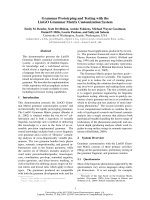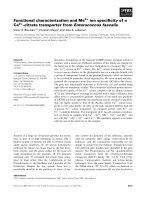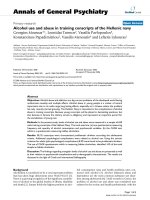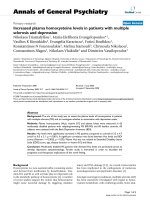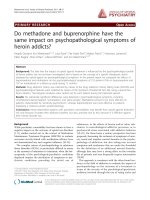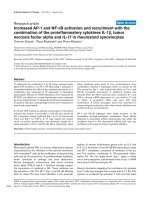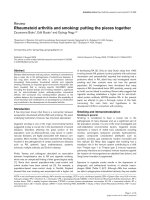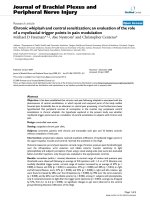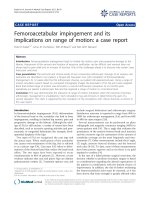Báo cáo y học: "κ Increased AP-1 and NF-κB activation and recruitment with the β combination of the proinflammatory cytokines IL-1β, tumor necrosis factor alpha and IL-17 in rheumatoid synoviocyte" ppt
Bạn đang xem bản rút gọn của tài liệu. Xem và tải ngay bản đầy đủ của tài liệu tại đây (309.74 KB, 9 trang )
R190
Introduction
Rheumatoid arthritis (RA) is a chronic inflammatory disease
characterized by the infiltration of the synovial membrane
with monocytes/T cells, by the proliferation of synovial lining
cells and by the production of proinflammatory cytokines,
which contribute to cartilage and bone destruction.
Recent therapeutic interventions with tumor necrosis
factor alpha (TNF-α) and IL-1 inhibitors strongly support
the importance of cytokines in RA. These cytokines are
key activators of the TFs AP-1, Egr-1 and NF-κB. Binding
sites for these TFs have been identified in the promoter
regions of several inflammatory genes such as IL-6 and
IL-8 [1,2]. Activation of the NF-κB/Rel transcription family
and AP-1 complexes, composed of members of the Jun
and Fos families, contributes to RA-associated inflam-
mation [3]. The zinc finger factor, Egr-1, plays a critical
role in bone resorption, and elevated levels of egr-1 mRNA
were found in RA synoviocytes [4].
Recent information regarding the contribution of cytokines
from T cells has emerged from results with IL-17 [5]. This
cytokine is produced by activated T cells and has been
ELISA = enzyme-linked immunosorbent assay; FCS = fetal calf serum; FITC = fluorescein isothiocyanate; IL = interleukin; NF = nuclear factor;
OPG = osteoprotegerin; PBS = phosphate-buffered saline; PCR = polymerase chain reaction; RA = rheumatoid arthritis; RT = reverse transcrip-
tase; TF = transcription factor; TNF-α = tumor necrosis factor alpha.
Arthritis Research & Therapy Vol 6 No 3 Granet et al.
Research article
Increased AP-1 and NF-
κκ
B activation and recruitment with the
combination of the proinflammatory cytokines IL-1
ββ
, tumor
necrosis factor alpha and IL-17 in rheumatoid synoviocytes
Corinne Granet
1
, Wova Maslinski
2
and Pierre Miossec
1
1
Department of Immunology and Rheumatology, INSERM U403, Hôpital E Herriot, Lyon, France
2
Department of Pathophysiology and Immunology, Institute of Rheumatology, Warsaw, Poland
Corresponding author: Pierre Miossec (e-mail: )
Received: 24 Nov 2003 Revisions requested: 15 Dec 2003 Revisions received: 27 Jan 2004 Accepted: 12 Feb 2004 Published: 26 Feb 2004
Arthritis Res Ther 2004, 6:R190-R198 (DOI 10.1186/ar1159)
© 2004 Granet et al., licensee BioMed Central Ltd. This is an Open Access article: verbatim copying and redistribution of this article are permitted
in all media for any purpose, provided this notice is preserved along with the article's original URL.
Abstract
To determine the contribution of IL-1β, tumor necrosis factor
alpha (TNF-α) and IL-17 to AP-1, NF-κB and Egr-1 activation in
rheumatoid arthritis, the effect of the cytokines used alone or in
combination was measured on TF expression in rheumatoid
synoviocytes. Effects on mRNA expression were measured by
RT-PCR and effects on nuclear translocation were measured
by immunocytochemistry. To assess the functional consequences
of cytokine induction, osteoprotegerin levels were measured in
synoviocyte supernatants.
IL-1β and TNF-α alone at optimal concentration (100 pg/ml)
induced the nuclear translocation of NF-κB and almost all
AP-1 members, except JunB and Egr-1 for IL-1β and except
Fra-2 and Egr-1 for TNF-α. IL-17 was clearly less potent
since no nuclear translocation was observed, except for a
weak activation of Fra-1 and NF-κB. More importantly, when
these cytokines were used at low concentrations, their
combination showed a synergistic effect on almost all the
TFs, except for Egr-1, with a particular effect on Fra-1 and
NF-κB. Increased recruitment of additional factors was
induced when the three cytokines were combined. IL-1 and
TNF-α induced mRNA expression of c-jun while IL-17 had
no effect. A synergistic effect was seen with their
combination. A similar synergistic effect was observed for
osteoprotegerin production when these three cytokines were
combined at low concentrations.
AP-1 and NF-κB pathways were highly sensitive to the
combination through synergistic mechanisms. These effects
observed in rheumatoid arthritis synoviocytes may reflect the
conditions found in the rheumatoid arthritis joint and may
contribute to the mode of action of cytokine inhibitors.
Keywords: proinflammatory cytokines, rheumatoid arthritis, synoviocytes, transcription factors
Open Access
Available online />R191
found in RA synovium [6]. Less is known about the
molecular signaling mechanisms induced by IL-17. Like
IL-1β and TNF-α, IL-17 activates NF-κB and AP-1 in
human fibroblasts [7]. Furthermore, a combination of IL-1β
or TNF-α with IL-17 was found to be synergistic in
synoviocytes [8–10], in bone stromal cells [11], in bone
and in meniscus explants [12–14].
Many studies have considered these cytokines acting
alone at concentrations that may not be achieved in vivo.
Conversely, in diseases such as RA, cytokines are present
in combination but at lower concentrations. Accordingly,
understanding of such synergistic activation is critical as
this may lead to new therapeutic applications.
To determine the contribution of TFs in the pathogenesis of
RA, we evaluated the expression and function of AP-1,
NF-κB and Egr-1 in human RA synoviocytes by RT-PCR
and by immunocytochemistry after induction with IL-1, TNF-α
and IL-17 alone and in combination. To assess the functional
consequences of these conditions, osteoprotegerin (OPG)
levels were measured in synoviocyte supernatants.
The present study indicated that optimal concentrations of
IL-1 and TNF-α induced most of these factors, while IL-17
had a weak effect. The combination of low concentrations
of these cytokines, however, was able to induce synergistic
effects associated with the recruitment of additional
factors not induced by individual cytokines at the same
concentration. The same conclusion was observed at the
protein level.
Materials and methods
Materials
RPMI 1640, FCS, L-glutamin, antibiotics, Trypsin–EDTA,
Hoechst H33258, orthophenylenediamine and other
products for cell culture were from Sigma (St Quentin
Fallavier, France). Primary polyclonal and secondary FITC-
conjugated antibodies were from Santa Cruz Biotechnology
Inc. (Santa Cruz, CA, USA). IL-1β, TNF-α and IL-17 were
from Sigma. Trizol
®
Reagent, Superscript II™ Reverse
Transcriptase and Platinum
®
Taq DNA Polymerase were
from Invitrogen (Cergy Pontoise, France). The primers
were obtained from Eurobio (Les Ulis, France). Antihuman
OPG monoclonal antibody MAB8051, recombinant
human OPG/Fc chimera 805-OS and biotinylated goat
IgG antihuman OPG antibody (BAF805) were obtained
from R&D systems (Abingdon, UK).
Cell culture
Rheumatoid synovium samples were obtained from
patients with RA, according to the revised criteria of the
American College of Rheumatology [15], who were
undergoing synovectomy and/or joint replacement. Briefly,
synovium samples were cut into small pieces and
digested with 1 mg/ml collagenase and DNase in RPMI
1640 for 2 hours at 37°C to isolate synoviocytes. After
centrifugation, cells were suspended in complete RPMI
1640 medium supplemented with 10% FCS, 2 mM
L-glutamin and 1% (v/v) antibiotics mixture (10,000 U
penicillin and 10 mg streptomycin) and were cultured in
100 mm culture petri dishes. At confluence, cells were
trypsinized and passaged. Cells were grown in 75 cm
2
flasks in completed RPMI 1640. Cells were plated at a
density of 1 × 10
4
cells/cm
2
onto glass coverslips (diameter,
12 mm). When subconfluent, cells were deprived of FCS
for 12 hours and then were stimulated either with IL-1β,
TNF-α or IL-17, or with combinations of these cytokines.
Immunofluorescence staining
Immunofluorescence staining was performed on control
and stimulated rheumatoid synoviocytes (i.e. before and
30 min after cytokine addition). After removal of the culture
medium, cells were fixed overnight at 4°C with 4%
paraformadehyde and washed intensively (3 × 5 min) with
1 × PBS. Cells were then permeabilized for 3 min in 0.1%
Triton X-100/1 × PBS, followed by three washings. Non-
specific binding was abolished by incubation for 1 hour at
room temperature in blockade solution (1 × PBS, 0.1%
bovine serum albumin). Polyclonal primary antibodies (anti-
AP-1, anti-Egr-1 and anti-p65 NF-κB), diluted 1:100, were
added for 1 hour at room temperature and the cells were
washed again in PBS. Samples were then incubated at
room temperature for 1 hour in blockade solution. After-
wards, cells were washed in PBS and incubated with
polyclonal secondary FITC-conjugated antibodies (diluted
1:100) for 1 hour at room temperature. Cells were then
washed in PBS and incubated for 30 min at room
temperature with 0.5 µg/ml Hoechst H33258. After PBS
washings, samples were mounted in PBS/glycerol 80%.
Nuclear translocations were confirmed by nuclear staining
with Hoechst H33258. Image acquisition was performed
with a fluorescence microscope (Leica, Paris, France)
coupled to a video camera (Nikon, Champigny, France).
The mean green intensity of the nuclear staining was
quantified with Lucia
®
image analysis software in 10
randomly selected cells.
RNA isolation and RT-PCR
RNA extraction was performed with control and stimulated
RA synoviocytes before and 20 min after cytokine addition.
Total RNA was isolated by guanidium isothiocyanate
extraction using Trizol
®
reagent. Briefly, the samples were
disrupted in lysis buffer, separated into a phenol–
chloroform phase and precipitated. Pellets were dissolved
into RNAse-free water. Total RNA was quantitated using
the SmartSpec™3000 (Bio-Rad, Marnes la Coquette,
France). The integrity of RNA was checked by loading
1 µg (based on OD
260
) per lane on 1% agarose–1 × TAE
gel, separated by electrophoresis. Equal loading of the
RNA was confirmed by ethidium bromide staining.
Arthritis Research & Therapy Vol 6 No 3 Granet et al.
R192
One to three micrograms of total RNA were reverse-trans-
cribed into single-strand cDNA using 25 µg/ml oligo(dT)
12–18
primer, 0.5 mM each dNTP, 40 U/µl RNase Out™ inhibitor,
0.01 M dithiothreitol and 10 U/µl Superscript II™ reverse
transcriptase in the first strand. The reaction was
incubated for 50 min at 42°C and for 15 min at 70°C. The
single-strand cDNA was then diluted and samples were
amplified using Platinum
®
Taq DNA Polymerase (Invitrogen)
in a 50 µl PCR mixture containing (20 mM Tris–HCl and
50 mM KCl) PCR buffer with 1.5 mM MgCl
2
, 0.2 µM 5′
and 3′ oligo-primers, 0.2 mM each dNTP and 2.5 U
Platinum
®
Taq DNA Polymerase. Amplification reactions
were performed in a thermal cycler (Gene Amp
®
PCR
System 9700 Biosystems; Perkin Elmer, Courtaboeuf,
France). The cycle number was optimized to examine the
relative expression of each of the RT-PCR products within
their linear range of amplification.
The oligonucleotide primer sequences were as follows: for
c-jun, the forward primer was 5′-GGA AAC GAC CTT
CTA TGA CGA TGC CCT CAA-3′ and the downward
primer was 5′-GAA CCC CTC CTG CTC ATC TGT CAC
GTT CTT-3′; for
β
-actin, the forward primer was 5′-GGG
TCA GAA GGA TTC CTA TG-3′ and the downward
primer was 5′-CTC CTT AAT GTC ACG CAC GAT TTC-3′.
The housekeeping gene
β
-actin was amplified as an
internal control. PCR fragments were analyzed by electro-
phoresis on 1% agarose–1 × TAE gel containing ethidium
bromide, visualized by UV illumination. The intensities of
the respective
β
-actin and c-jun bands were measured by
densitometry using an Alpha Imager
®
and the software
Image Tool
®
. Results were expressed as the ratio
between c-jun values divided by those of the internal
control
β
-actin and were the mean of three independent
experiments.
Determination of OPG levels by ELISA
Supernatants from synoviocytes stimulated with cytokines
were cultured and collected 72 hours after cytokine
addition. Concentrations of OPG were measured with a
sandwich ELISA using the set of specific antibodies and
the OPG/Fc standard from R&D Systems as described
elsewhere [16]. MaxiSorp plates were coated overnight at
4°C with antihuman monoclonal OPG antibody (MAB8051).
After several washings and saturation steps, diluted
samples and serial dilutions of OPG/Fc standard
(805-OS) were added and incubated for 1 hour at room
temperature. After washings, the detecting biotinylated
goat IgG anti-human OPG antibody (BAF805) was added
for 1 hour at 37°C. Peroxidase-conjugated streptavidin
(Jackson ImmunoResearch, West Grove, PA, USA) was
then incubated for 20 min at room temperature. The
peroxidase reaction was developed using orthophenylene-
diamine as a substrate and was stopped with 1 M sulfuric
acid. The plates were read at 492 nm. The sensitivity of the
assays was 40 pg/ml.
Statistical analysis
Results are expressed as the mean ± standard deviation.
Data were analyzed using the Kruskall–Wallis one-way
analysis of variance test. P < 0.05 was considered statisti-
cally significant.
Results
Dose effect of cytokines on c-Fos, c-Jun, Egr-1 and
NF-
κκ
B nuclear translocation
We first tested the effect of IL-1β, TNF-α and IL-17 alone
on RA synoviocytes to define the minimal and optimal
concentrations able to induce nuclear translocation of the
major TFs. A time course was performed and 30 min after
the initiation of stimulation appeared to be a time point
where most of the TFs were observed in the nucleus (data
not shown). After 30 min of stimulation with increasing
cytokine concentrations, cells were fixed and stained. The
dose effect of each cytokine was evaluated by the
measurement of the mean green intensity of the nuclear
staining with image analysis software. The quantitative
data are presented in Table 1. Results are compared with
the condition using medium alone.
RA synoviocytes did not show any TF translocation
without cytokine. With increasing concentrations of IL-1β,
ranging from 0 to 500 pg/ml, C-Fos and C-Jun were found
in the nucleus with concentrations from 100 to 500 pg/ml
(P < 0.001 versus medium alone). NF-κB activation was
more sensitive since a concentration as low as 10 pg/ml
was sufficient (P < 0.01 versus medium). For IL-1β concen-
trations ranging from 0 to 500 pg/ml, no translocation was
observed for Egr-1. Accordingly, an optimal concentration
of 100 pg/ml IL-1β was chosen as a positive control for
further experiments, while a suboptimal concentration of
10 pg/ml IL-1β had a weak effect only on NF-κB trans-
location.
Similarly, with concentrations of TNF-α ranging from 0 to
500 pg/ml, C-Fos and C-Jun translocation was observed
in the nucleus (P < 0.01 and P < 0.001, respectively).
NF-κB nuclear localization was observed for the same
concentrations (P < 0.001) while no Egr-1 translocation
was observed. Accordingly, the optimal concentration of
TNF-α was defined as 100 pg/ml.
IL-17 activation was clearly less potent since concentra-
tions of IL-17 as high as 100 ng/ml did not have an effect
on C-Fos, C-Jun or Egr-1 nuclear translocation. These
concentrations did, however, induce NF-κB translocation
(P < 0.01 versus medium).
Effect of individual cytokines on other TF translocation
Initial experiments were performed to establish the optimal
conditions under which a first set of factors was activated.
Additional experiments were performed to study the other
members of the AP-1 complex. Fra-1, Fra-2, FosB, JunB
and JunD nuclear translocation was evaluated after 30 min
of cytokine addition at low and optimal concentrations
(Table 1).
As already observed for C-Fos, C-Jun, and NF-κB, 30 min
of treatment with IL-1β (100 pg/ml) induced a nuclear
translocation of FosB, Fra-1, Fra-2 and JunD (P < 0.001
versus medium alone), but not of JunB. Conversely, a
concentration of 10 pg/ml IL-1β had no effect except on
Fra-1 (P < 0.01) and on NF-κB (P < 0.01).
TNF-α (100 pg/ml) induced a nuclear localization of FosB,
Fra-1, JunB and JunD (P < 0.001 versus medium), but not
of Fra-2. FosB activation was more sensitive to the effect
of TNF-α, since a concentration as low as 10 pg/ml was
sufficient to induce its translocation (P < 0.001 versus
medium).
IL-17 (100 ng/ml) had a weak effect on Fra-1 (P < 0.05)
but not on FosB, on Fra-2, on JunB and on JunD. A
concentration of 50 ng/ml IL-17 had no effect.
Effect of cytokine combination on TF nuclear
translocation
IL-1β and TNF-α are mainly produced by monocytes while
IL-17 is produced by T cells. To reproduce the inter-
actions observed in the synovium, these three cytokines
were combined at low concentrations, which may reflect
the in vivo situation.
Combined treatment with low concentrations of IL-1β and
of TNF-α induced a nuclear translocation of all TFs except
Egr-1 (Fig. 1). A synergistic effect was observed since the
same low concentrations of IL-1β or TNF-α used alone
had no effect. C-Jun was particularly sensitive to the effect
of the combined treatment of IL-1β and TNF-α.
Furthermore, an enhanced stimulation was observed for
Fra-1 and NF-κB when compared with the effect observed
with individual cytokines at low concentration. Figure 2
shows a representative experiment in which a nuclear
localization of C-Jun was observed in most cells after
stimulation with the combination of low concentrations of
cytokines.
IL-17 treatment in combination with TNF-α further induced
the nuclear translocation of C-Fos, Fra-1, C-Jun and
NF-κB. In the same way, combined treatment with low
concentrations of IL-1β and of IL-17 showed a synergistic
effect on the nuclear translocation of C-Fos, of FosB, of
Fra-1, of Fra-2, of C-Jun, of JunD and of NF-κB. This
combination had a particular effect on Fra-1 and NF-κB
activation.
Available online />R193
Table 1
Dose effect of individual cytokines on TF nuclear translocation
c-Fos c-Jun Egr-1 NF-κB FosB Fra-1 Fra-2 JunB JunD
Medium 4.6 ± 3.6 2.5 ± 2.1 2.3 ± 2.3 2.7 ± 2.4 2.5 ± 2.6 3.5 ± 3.0 4.4 ± 2.8 3.3 ± 3.2 2.4 ± 2.1
IL-1
1 pg/ml 6.3 ± 5.1
†
4.9 ± 4.0
†
2.6 ± 2.4
†
3.5 ± 3.4
†
Not±done Not±done Not±done Not±done Not±done
10 pg/ml 5.1 ± 4.3
†
2.7 ± 2.5
†
2.4 ± 3.0
†
34.3 ± 3.6** 2.4 ± 2.1
†
36.5 ± 6.0** 2.8 ± 3.0
†
3.4 ± 3.0
†
2.0 ± 2.2
†
100 pg/ml 39.5 ± 7.2*** 33.2 ± 3.1*** 2.7 ± 2.1
†
72.3 ± 7.5*** 37.9 ± 4.7*** 69.2 ± 5.7*** 40.9 ± 5.5*** 2.2 ± 2.4
†
35.2 ± 3.8***
500 pg/ml 76.6 ± 10.8*** 70.1 ± 7.6*** 2.7 ± 3.2
†
73.5 ± 5.1*** Not±done Not±done Not±done Not±done Not±done
Tumor necrosis factor alpha
1 pg/ml 4.8 ± 4.2
†
4.1 ± 3.0
†
2.6 ± 2.5
†
3.8 ± 3.3
†
Not±done Not±done Not±done Not±done Not±done
10 pg/ml 2.9 ± 3.0
†
5.1 ± 2.6
†
2.2 ± 2.7
†
3.4 ± 2.6
†
36.2 ± 5.0*** 34.7 ± 3.8
†
4.3 ± 2.8
†
2.8 ± 3.0
†
3.3 ± 2.7
†
100 pg/ml 33.9 ± 3.8** 43.1 ± 7.0*** 4.9 ± 2.5
†
41.4 ± 4.3*** 38.8 ± 5.1*** 69.2 ± 5.0*** 3.8 ± 3.0
†
35.6 ± 4.3*** 41.2 ± 5.9***
500 pg/ml 68.9 ± 6.4** 72.6 ± 6.4*** 3.8 ± 2.3
†
66.1 ± 4.0*** Not±done Not±done Not±done Not±done Not±done
IL-17
50 pg/ml 4.5 ± 4.0
†
4.1 ± 2.2
†
4.4 ± 4.0
†
4.1 ± 2.8
†
3.8 ± 3.5
†
3.6 ± 2.9
†
3.9 ± 2.6
†
2.6 ± 2.6
†
3.1 ± 2.8
†
100 pg/ml 3.7 ± 3.7
†
6.5 ± 3.2
†
5.5 ± 5.8
†
35.8 ± 3.6** 3.3 ± 3.3
†
34.6 ± 1.3* 3.3 ± 2.6
†
2.4 ± 2.2
†
3.2 ± 2.6
†
After 30 min with cytokines at the cited concentrations, rheumatoid arthritis synoviocytes were fixed and immunofluorescence staining was
performed. Nuclear translocation was confirmed by nuclear staining with Hoechst H33258. Using image analysis software, the mean green
intensity of the nuclear staining was quantified in 10 randomly selected cells. Results are expressed as the mean of three independent experiments
(mean ± standard deviation). The results were analyzed with the Kruskall–Wallis test. *** P < 0.001 versus medium, ** P < 0.01 versus medium,
* P < 0.05 versus medium,
†
nonsignificant.
The combination of the three cytokines was even more
potent, leading to a synergistic effect on all of the TF
translocations except for Egr-1. This IL-1β, TNF-α and
IL-17 combination of cytokines had a particularly strong
synergistic effect on the nuclear translocation of Fra-1, of
C-Jun and of NF-κB.
Arthritis Research & Therapy Vol 6 No 3 Granet et al.
R194
Figure 1
Quantification of the effects of individual cytokines and their
combinations on TF nuclear translocation. After 12 hours of culture
without FCS, rheumatoid arthritis synoviocytes (10
4
cells/cm
2
) were
stimulated for 30 min with cytokines at the cited concentrations.
Immunofluorescence staining was performed with anti-TF specific
antibodies and was confirmed by Hoechst H33258 staining. Using an
image analysis software, the mean green intensity of nuclear staining
was quantified in 10 randomly selected cells. Results are expressed as
the mean of three independent experiments. Results were analyzed
using the Kruskall–Wallis test. *** P < 0.001, ** P < 0.01, * P < 0.05
versus medium alone. See Fig. 2 for an example of an actual picture.
TNF, tumor necrosis factor.
Figure 2
Effect of IL-1β, tumor necrosis factor alpha (TNF-α) and IL-17 used
alone and in combination on C-Jun translocation. Rheumatoid arthritis
synoviocytes were stimulated for 30 min with cytokines at the cited
concentrations. Cells were fixed in 4% paraformadehyde and
immunofluorescence staining was performed. Results are
representative of three independent experiments. Effects of
proinflammatory cytokines used alone at low and optimal
concentrations and in combination on C-Jun nuclear translocation after
30 min of exposure are shown.
Effect of proinflammatory cytokines on mRNA expression
To determine whether these effects were related to an
increase in translocation or in de novo synthesis we
examined the mRNA expression, looking at whether it was
particularly sensitive to a synergistic increase. The results
for c-jun are shown as an example before and 20 min after
cytokine treatment. At a suboptimal concentration of IL-1
(10 pg/ml) or TNF-α (10 pg/ml) c-jun mRNA expression
was observed, whereas IL-17 (50 ng/ml) had no effect.
These cytokines were then combined at these low
concentrations (IL-1, 10 pg/ml; TNF-α, 10 pg/ml; IL-17,
50 ng/ml) with no effect or a low effect when used alone.
Treatment with the combination of low concentrations of
IL-1 and TNF-α induced an additive effect on mRNA expres-
sion of c-jun, whereas the combination of low concen-
trations of IL-17 with TNF-α had no effect on the TNF-α-
induced expression of c-jun. In contrast, the combination
of low concentrations of IL-1 with IL-17 induced a
synergistic effect on IL-1 and induced c-jun mRNA
expression. This picture was similar to the effect seen with
the combination of IL-1, TNF-α and IL-17 (Fig. 3).
Effect of proinflammatory cytokines used alone or in
combination on OPG levels
We selected OPG as a marker of effects at the protein
level to look at a functional consequence of these inter-
actions of cytokines. Supernatants from RA fibroblast-like
synoviocytes were collected after 72 hours of culture
following cytokine addition. Concentrations of OPG were
measured by ELISA.
In medium alone, RA synoviocytes produced 1 ng/ml
OPG. The addition of IL-1 (10 pg/ml) doubled that produc-
tion, whereas TNF-α (10 pg/ml) or IL-17 (50 ng/ml) had
no effect (Fig. 4). The combination of IL-17 with IL-1 and,
moreover, with TNF-α further increased that production,
the effect being maximal when the three cytokines were
combined.
Discussion
Proinflammatory cytokines play an important role in the
pathogenesis of joint destruction and osteoporosis in RA.
Nevertheless, the mode of activation of these ubiquitous
TFs is poorly understood when interactions between
these cytokines are considered. In this study, we investi-
gated the nuclear translocation of AP-1 members, Egr-1
and NF-κB in RA synoviocytes after treatment with cyto-
kines alone or in combination. The first part of the study
extended previous reports on a limited number of trans-
criptional factors. At the same time, we have added results
on IL-17 in addition to TNF-α and IL-1β. We also studied
Available online />R195
Figure 3
Effects of IL-1β, tumor necrosis factor alpha (TNF-α) and IL-17 used
alone and in combination on c-jun mRNA expression. After 12 hours of
culture without FCS, rheumatoid arthritis fibroblast-like synoviocytes
were stimulated for 20 min with individual or combined cytokines at
low concentrations: IL-1 (10 pg/ml), TNF-α (10 pg/ml) and IL-17 (50
ng/ml). Cells were lyzed and total mRNA was extracted. RT-PCR was
performed as described in Materials and methods. The intensity of the
respective
β
-actin and c-jun bands was measured by densitometry.
Results were expressed as the ratio between c-jun values divided by
those of the internal control
β
-actin and were the mean of three
independent experiments. CT, control.
Figure 4
Determination of osteoprotegerin (OPG) levels in supernatants
obtained from rheumatoid arthritis (RA) synoviocytes stimulated by
proinflammatory cytokines alone or in combination. RA synoviocytes
were cultured with cytokines at the cited concentrations. After
72 hours of culture, supernatants were collected and OPG levels were
measured by ELISA. Results are expressed as the mean of three
independent experiments. TNF, tumor necrosis factor.
the functional consequences of cytokine treatment on
OPG production by RA synoviocytes.
The more interesting contribution is the demonstration of
synergistic interactions between the cytokine-induced TF
activation. It is important to consider that these results
were observed at the protein level and at the mRNA level,
suggesting that the observed effects are indeed functional.
We obtained similar findings previously for the production
of IL-6 [8,17].
Effects of IL-1
ββ
and TNF-
αα
on TF activation in RA
synoviocytes
The TF AP-1 is constitutively activated in the RA synovium
[1]. Used alone at an optimal concentration, IL-1β and
TNF-α induced the nuclear translocation of most of the
AP-1 members, except JunB for IL-1β and except Fra-2 for
TNF-α. Used alone at low concentrations, IL-1β induced a
weak activation of Fra-1 and TNF-α induced an activation
of FosB and Fra-1. The combination of these two
cytokines at low concentrations induced the nuclear
translocation of all the AP-1 members, with a particular
effect on Fra-1 and C-Jun.
NF-κB is expressed in RA synovial cells, and is further
induced by treatment with TNF-α or with IL-1β [18]. In our
experiments, both IL-1β and TNF-α at high concentrations
activated NF-κB nuclear translocation in RA synoviocytes.
Used alone at a low concentration, IL-1β induced a weak
activation of NF-κB. This effect was significantly increased
in combination with a low concentration of TNF-α.
Elevated levels of egr-1 mRNA have been described in RA
synoviocytes [4]. However, when used alone at optimal
concentrations or in combination, IL-1β and TNF-α did not
induce Egr-1 nuclear translocation. Opposite results have
been reported where treatment with TNF-α or IL-1β
induced egr-1 mRNA expression and Egr-1 nuclear
translocation [19,20]. Such a discrepancy is not clearly
understood since the same antibody used here was
previously able to detect Egr-1 in the nucleus of an
osteoblastic cell line [21].
Effect of IL-17 on TF activation in RA synoviocytes
Although there are elevated levels of IL-17 in synovial fluid
of patients with RA, the pathogenic role of IL-17 in the
development of RA remains to be elucidated [5]. We
therefore examined whether IL-17 alone could affect
synoviocytes through mechanisms involving AP-1, NF-κB
and Egr-1 pathways.
Limited information is available on the effect of IL-17 on
AP-1. Here, IL-17 alone had a weak effect compared with
that of IL-1β or TNF-α. Indeed, IL-17 alone at a high
concentration induced nuclear translocation only of Fra-1.
In osteoarthritic chondrocytes, IL-17 was found to induce
FosB and JunB [22]. IL-17 at optimal concentration also
had a weak effect on NF-κB translocation. The weak effect
of IL-17 indicates that it has rather a regulatory effect,
leading to the amplification of the action of other cytokines.
Contribution of the T-cell-derived cytokine IL-17 to IL-1
ββ
and TNF
αα
TF activation in RA synoviocytes
T cells and monocytes are two major cell types involved in
RA pathogenesis. Some of their derived cytokines may be
present at very low concentrations in the RA joint, and
their effects could then be significantly potentiated.
Synergy between IL-17 and IL-1β or TNF-α was first
described with RA synoviocytes [8] and later in myoblasts
[23]. IL-17 alone had a weak effect here yet, when
associated with IL-1β and/or TNF-α at low concentrations,
a synergistic effect was found for almost all of the TFs.
Similarly, in myofibroblasts, IL-6 production was enhanced
by IL-17 combined with IL-1β and TNF-α through an
activation of NF-κB [23,24]. The effects of IL-17 with TNF-α
were much stronger than those induced by IL-17 with
IL-1β in these cells. Moreover, the combination of IL-17
and IL-1β further increased C-Fos, C-Jun and NF-κB
activation [23]. Conversely, in RA synoviocytes, we found
a higher effect of the combination of IL-17 with IL-1β than
with TNF-α. The strongest effect was observed for the
combination of the three proinflammatory cytokines.
Even more interesting is the fact that some factors not
activated by individual cytokine treatment were stimulated
with their combination. Fra-1 and NF-κB were particularly
sensitive to this effect, suggesting that these TFs are
important mediators of IL-1β, TNF-α and IL-17 signaling
pathways in vivo. In a previous study, such a combination
at low concentrations was able to promote the nuclear
translocation of NF-κB in the osteoblastic cell line
ROS 17/2.8, also with a major synergistic effect [21].
Effects of IL-1, TNF-
αα
and IL-17 combination on c-
jun
mRNA expression
To differentiate between an increase in translocation or in
protein synthesis, we looked at the mRNA expression
using the same cytokine combination. Induction of c-jun
mRNA expression was induced by IL-1 or TNF-α used
alone, as previously described for c-fos and c-jun mRNA
levels in fibroblasts [25–27]. At these low concentrations
the two cytokines had a weak effect when used alone but
their combination showed an additive effect, with IL-17
alone having no effect. A synergistic effect was observed
particularly when the three cytokines were combined.
Effects of IL-1, TNF-
αα
and IL-17 on OPG production
To extend these findings to the protein level, we looked at
levels of OPG in supernatants obtained from RA synovio-
cytes stimulated with the same cytokine combination
[16,28]. Elevated levels of OPG were found in synovial
Arthritis Research & Therapy Vol 6 No 3 Granet et al.
R196
fluid and in serum from RA patients when compared with
controls [16,29]. IL-1 and TNF-α are known inducers of
OPG production in cultured synoviocytes [16,30], in
periodontal ligament cells and in pulp cells [31]. Similar
results were observed with vascular endothelial cells
regarding RANK-L and OPG expression [32]. OPG
mRNA levels in MG-63 osteoblastic cells increased in a
dose-dependent and time-dependent manner after IL-1
and TNF treatment [33,34]. In the collagen arthritis model,
overexpression of IL-17 not only enhanced RANK-L
expression, but also strongly upregulated the RANK-L/
OPG ratio in the synovium [35].
Here we show the lack of effect of IL-17 alone, contrasting
with the increase in OPG levels after IL-17 treatment
when combined with IL-1 and/or TNF-α. In contrast, the
combination of IL-1 with TNF-α had no effect. Since OPG
is a negative regulator of RANK–RANK-L interaction, this
effect of cytokines may represent a feedback loop to
control bone destruction.
Application to cytokine inhibition
in vivo
Since IL-1β and TNF-α are the key mediators in RA, their
control represents a major therapeutic goal. Data from
clinical trials showed clear efficacy, but also revealed that
blockade of these cytokines did not fully control arthritis in all
patients. Our study demonstrated the potency of cytokine
combination at low concentrations. Accordingly, combination
therapy acting on more than one cytokine may contribute to
a better effect. The basis for such a concept has already
been obtained with ex vivo models of RA-associated joint
inflammation and destruction [17]. Controlling the T-cell-
derived cytokine IL-17 and either IL-1β or TNF-α appears
more critical than the combined inhibition of IL-1β and TNF-α.
Since AP-1 and NF-κB are common pathways for these
cytokines, neutralizing these TFs directly or by acting on their
upstream kinases may have an increased effect when
compared with a single cytokine inhibition.
Conclusion
These findings indicate that interactions between cyto-
kines have to be considered, regarding their mode of
action and their contribution to disease. In conditions
where individual cytokines had no significant effect, their
combination resulted in a dramatic induction of TFs.
Conversely, removal of this contribution with a single
inhibitor may lead to a profound reduction of activation.
This concept may explain both the impressive effect of
cytokine inhibitors in many RA patients as well as their
failure in a subset of these patients.
Competing interests
None declared.
Acknowledgement
Supported in part by a grant from l’Association de Recherche sur la
Polyarthrite.
References
1. Asahara H, Fujisawa K, Kobata T, Hasunuma T, Maeda T,
Asanuma M, Ogawa N, Inoue H, Sumida T, Nishioka K: Direct evi-
dence of high DNA binding activity of transcription factor AP-1
in rheumatoid arthritis synovium. Arthritis Rheum 1997, 40:
912-928.
2. Marok R, Winyard PG, Coumbe A, Kus ML, Gaffney K, Blades S,
Mapp PI, Morris CJ, Blake DR, Kaltschmidt C, Baeuerle PA: Activa-
tion of the transcription factor nuclear factor-kappaB in human
inflamed synovial tissue. Arthritis Rheum 1996, 39:583-591.
3. Firestein GS, Manning AM: Signal transduction and transcrip-
tion factors in rheumatic disease. Arthritis Rheum 1999, 42:
609-621.
4. Grimbacher B, Aicher WK, Peter HH, Eibel H: Measurement of
transcription factor c-fos and EGR-1 mRNA transcription
levels in synovial tissue by quantitative RT-PCR. Rheumatol Int
1997, 17:109-112.
5. Miossec P: Interleukin-17 in rheumatoid arthritis: if T cells
were to contribute to inflammation and destruction through
synergy. Arthritis Rheum 2003, 48:594-601.
6. Chabaud M, Durand JM, Buchs N, Fossiez F, Page G, Frappart L,
Miossec P: Human interleukin-17: a T cell-derived proinflam-
matory cytokine produced by the rheumatoid synovium.
Arthritis Rheum 1999, 42:963-970.
7. Kehlen A, Thiele K, Riemann D, Langner J: Expression, modula-
tion and signalling of IL-17 receptor in fibroblast-like synovio-
cytes of patients with rheumatoid arthritis. Clin Exp Immunol
2002, 127:539-546.
8. Chabaud M, Page G, Miossec P: Enhancing effect of IL-1, IL-17,
and TNF-alpha on macrophage inflammatory protein-3alpha
production in rheumatoid arthritis: regulation by soluble
receptors and Th2 cytokines. J Immunol 2001, 167:6015-6020.
9. Katz Y, Nadiv O, Beer Y: Interleukin-17 enhances tumor necro-
sis factor alpha-induced synthesis of interleukins 1, 6, and 8
in skin and synovial fibroblasts: a possible role as a ‘fine-
tuning cytokine’ in inflammation processes. Arthritis Rheum
2001, 44:2176-2184.
10. Chabaud M, Garnero P, Dayer JM, Guerne PA, Fossiez F, Miossec
P: Contribution of interleukin 17 to synovium matrix destruc-
tion in rheumatoid arthritis. Cytokine 2000, 12:1092-1099.
11. Fossiez F, Djossou O, Chomarat P, Flores-Romo L, Ait-Yahia S,
Maat C, Pin JJ, Garrone P, Garcia E, Saeland S, Blanchard D,
Gaillard C, Das Mahapatra B, Rouvier E, Golstein P, Banchereau
J, Lebecque S: T cell interleukin-17 induces stromal cells to
produce proinflammatory and hematopoietic cytokines. J Exp
Med 1996, 183:2593-2603.
12. Chabaud M, Miossec P: The combination of tumor necrosis
factor alpha blockade with interleukin-1 and interleukin-17
blockade is more effective for controlling synovial inflamma-
tion and bone resorption in an ex vivo model. Arthritis Rheum
2001, 44:1293-1303.
13. LeGrand A, Fermor B, Fink C, Pisetsky DS, Weinberg JB, Vail TP,
Guilak F: Interleukin-1, tumor necrosis factor alpha, and inter-
leukin-17 synergistically up-regulate nitric oxide and prosta-
glandin E2 production in explants of human osteoarthritic
knee menisci. Arthritis Rheum 2001, 44:2078-2083.
14. Van Bezooijen RL, Van Der Wee-Pals L, Papapoulos SE, Lowik
CW: Interleukin 17 synergises with tumour necrosis factor
alpha to induce cartilage destruction in vitro. Ann Rheum Dis
2002, 61:870-876.
15. Arnett FC, Edworthy SM, Bloch DA, McShane DJ, Fries JF,
Cooper NS, Healey LA, Kaplan SR, Liang MH, Luthra HS, et al.:
The American Rheumatism Association 1987 revised criteria
for the classification of rheumatoid arthritis. Arthritis Rheum
1988, 31:315-324.
16. Ziolkowska M., Kurowska M, Radzikowska A, Luszczykiewicz G,
Wiland P, Dziewczopolski W, Filipowicz-Sosnowska A, Pazdur J,
Szechinski J, Kowalczewski J, Rell-Bakalarska M, Maslinski W:
High levels of osteoprotegerin and soluble receptor activator
of nuclear factor kappa B ligand in serum of rheumatoid
arthritis patients and their normalization after anti-tumor
necrosis factor alpha treatment. Arthritis Rheum 2002, 46:
1744-1753.
17. Chabaud M, Lubberts E, Joosten L, van Den Berg W, Miossec P:
IL-17 derived from juxta-articular bone and synovium con-
tributes to joint degradation in rheumatoid arthritis. Arthritis
Res 2001, 3:168-177.
Available online />R197
18. Suzuki M, Tetsuka T, Yoshida S, Watanabe N, Kobayashi M,
Matsui N, Okamoto T: The role of p38 mitogen-activated
protein kinase in IL-6 and IL-8 production from the TNF-alpha-
or IL-1beta-stimulated rheumatoid synovial fibroblasts. FEBS
Lett 2000, 465:23-27.
19. Grimbacher B, Aicher WK, Peter HH, Eibel H: TNF-alpha
induces the transcription factor Egr-1, pro-inflammatory
cytokines and cell proliferation in human skin fibroblasts and
synovial lining cells. Rheumatol Int 1998, 17:185-192.
20. Cao XM, Guy GR, Sukhatme VP, Tan YH: Regulation of the Egr-
1 gene by tumor necrosis factor and interferons in primary
human fibroblasts. J Biol Chem 1992, 267:1345-1349.
21. Granet C, Miossec P: Combination of the pro-inflammatory
cytokines IL-1, TNF-a and IL-17 leads to enhanced and addi-
tional recruitment of AP-1 members, Egr-1 and NF-kB in
osteoblast-like cells [abstract]. Arthritis Res Ther 2003,
5(Suppl 1):38.
22. Benderdour M, Tardif G, Pelletier JP, Di Battista JA, Reboul P,
Ranger P, Martel-Pelletier J: Interleukin 17 (IL-17) induces collage-
nase-3 production in human osteoarthritic chondrocytes via AP-
1 dependent activation: differential activation of AP-1 members
by IL-17 and IL-1beta. J Rheumatol 2002, 29:1262-1672.
23. Chevrel G, Page G, Granet C, Streichenberger N, Varennes A,
Miossec P: Interleukin-17 increases the effects of IL-1 beta on
muscle cells: arguments for the role of T cells in the patho-
genesis of myositis. J Neuroimmunol 2003, 137:125-133.
24. Hata K, Andoh A, Shimada M, Fujino S, Bamba S, Araki Y, Okuno
T, Fujiyama Y, Bamba T: IL-17 stimulates inflammatory
responses via NF-kappaB and MAP kinase pathways in
human colonic myofibroblasts. Am J Physiol Gastrointest Liver
Physiol 2002, 282:G1035-G1044.
25. Wakisaka S, Suzuki N, Takeno M, Takeba Y, Nagafuchi H, Saito
N, Hashimoto H, Tomita T, Ochi T, Sakane T: Involvement of
simultaneous multiple transcription factor expression, includ-
ing cAMP responsive element binding protein and OCT-1, for
synovial cell outgrowth in patients with rheumatoid arthritis.
Ann Rheum Dis 1998, 57:487-494.
26. Lin JX, Vilcek J: Tumor necrosis factor and interleukin-1 cause
a rapid and transient stimulation of c-fos and c-myc mRNA
levels in human fibroblasts. J Biol Chem 1987, 262:11908-
11911.
27. Guy GR, Cao X, Chua SP, Tan YH: Okadaic acid mimics multi-
ple changes in early protein phosphorylation and gene
expression induced by tumor necrosis factor or interleukin-1.
J Biol Chem 1992, 267:1846-1852.
28. Haynes DR, Crotti TN, Loric M, Bain GI, Atkins GJ, Findlay DM:
Osteoprotegerin and receptor activator of nuclear factor
kappaB ligand (RANKL) regulate osteoclast formation by cells
in the human rheumatoid arthritic joint. Rheumatology 2001,
40:623-630.
29. Feuerherm AJ, Borset M, Seidel C, Sundan A, Leistad L,
Ostensen M, Faxvaag A: Elevated levels of osteoprotegerin
(OPG) and hepatocyte growth factor (HGF) in rheumatoid
arthritis. Scand J Rheumatol 2001, 30:229-234.
30. Yano K, Nakagawa N, Yasuda H, Tsuda E, Higashio K: Synovial
cells from a patient with rheumatoid arthritis produce osteo-
clastogenesis inhibitory factor/osteoprotegerin: reciprocal
regulation of the production by inflammatory cytokines and
basic fibroblast growth factor. J Bone Miner Metab 2001, 19:
365-372.
31. Sakata M, Shiba H, Komatsuzawa H, Fujita T, Ohta K, Sugai M,
Suginaka H, Kurihara H: Expression of osteoprotegerin (osteo-
clastogenesis inhibitory factor) in cultures of human dental
mesenchymal cells and epithelial cells. J Bone Miner Res
1999, 14:1486-1492.
32. Collin-Osdoby P, Rothe L, Anderson F, Nelson M, Maloney W,
Osdoby P: Receptor activator of NF-kappa B and osteoprote-
gerin expression by human microvascular endothelial cells,
regulation by inflammatory cytokines, and role in human
osteoclastogenesis. J Biol Chem 2001, 276:20659-20672.
33. Vidal ON, Sjogren K, Eriksson BI, Ljunggren O, Ohlsson C:
Osteoprotegerin mRNA is increased by interleukin-1 alpha in
the human osteosarcoma cell line MG-63 and in human
osteoblast-like cells. Biochem Biophys Res Commun 1998,
248:696-700.
34. Brandstrom H, Jonsson KB, Vidal O, Ljunghall S, Ohlsson C,
Ljunggren O: Tumor necrosis factor-alpha and -beta upregu-
late the levels of osteoprotegerin mRNA in human osteosar-
coma MG-63 cells. Biochem Biophys Res Commun 1998, 248:
454-457.
35. Lubberts E, van den Bersselaar L, Oppers-Walgreen B,
Schwarzenberger P, Coenen-de Roo CJ, Kolls JK, Joosten LA, van
der Berg WB: IL-17 promotes bone erosion in murine colla-
gen-induced arthritis through loss of the receptor activator of
NF-kappa B ligand/osteoprotegerin balance. J Immunol 2003,
170:2655-2662.
Correspondence
Professor P Miossec, Clinical Immunology Unit, Departments of
Immunology and Rheumatology, Hospital E Herriot, 5 place d’Arsonval,
69437 Lyon cedex 03, France. Tel: +33 4 72 11 74 87; fax: +33 4 72
11 74 29; e-mail:
Arthritis Research & Therapy Vol 6 No 3 Granet et al.
R198
